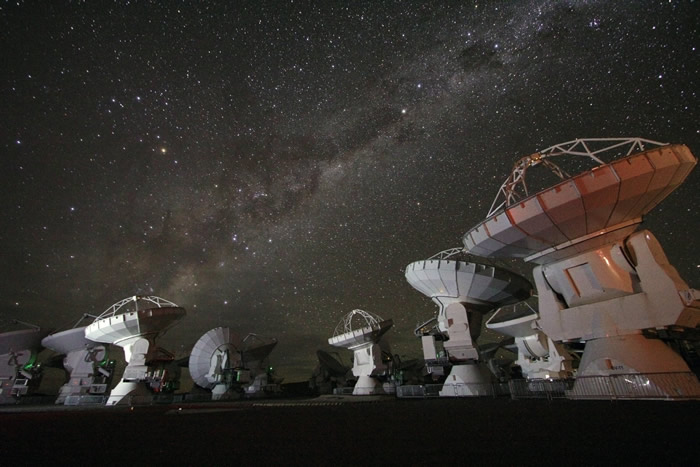ALMA and the Milky Way from the Southern Hemisphere
Night Scape Photograph・

| Date | March 14, 2013 (Chilean Standard Time) |
|---|---|
| Camera | Canon EOS Kiss X4 |
| Lens | Canon EF20mm F2.8 USM |
| Exposure | F4.0, 30 seconds, ISO3200 |
| Location | ALMA Array Operation Site (Atacama Desert, Chile) |
| Photographer | Kuninori Iwashiro (Public Relations Center, NAOJ) |
| Copyright | National Astronomical Observatory of Japan |
On March 13, 2013 (Chilean Standard Time), in a remote part of the Atacama Desert in Chile the Atacama Large Millimeter/submillimeter Array (ALMA) was inaugurated at an official opening ceremony. This photograph of the starry night sky was taken the day after the ceremony near the ALMA Array Operation Site.
The ALMA Array Operation Site is located on the Atacama Plateau at an elevation of 5,000 meters. Thanks to crystal clear transparency at this altitude and location, the night sky is said to be the world’s most beautiful.
The Southern Hemisphere offers a night sky unlike any viewed in Japan, with huge amounts of stars and where Class-VI stars are also clearly visible, making it sometimes difficult to even connect the shapes of constellations. Visible in the upper right of the photograph is the Southern Cross, which is almost buried in the Milky Way.
ALMA is an international partnership between East Asia, Europe, and North America in cooperation with the Republic of Chile. The shape of each radio telescope built by participating countries is different and this photograph shows the varying antennas of each.
The day the photograph was taken the radio telescopes were positioned relatively close to one another, but in the future they will be positioned across a range of up to 18.5km. This means that the image taken in this photograph of the radio telescope located close together will no longer be seen.
(Author:Kuninori Iwashiro (Public Relations Center, NAOJ))